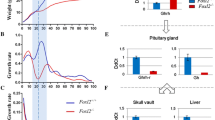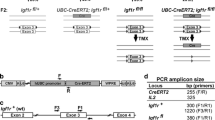Abstract
Insulin-like growth factor-I (IGF-I) mediated signalling has been implicated to be of significant importance during vertebrate embryonic development. IGF-I signalling has also been shown to be modulated by a number of IGF binding proteins that are thought to act as either agonists or antagonists of IGF activity. IGF-I has been implicated in a number of cellular processes, including cell division and programmed cell death (apoptosis). We have used the mouse mutant Hypodactyly (Hd) as a tool to determine the role of IGF-I and two key IGF binding proteins (IGFBP-2 and IGFBP-5) during embryonic development. The Hd mutant is a good model with which to study developmental cascades, since it has a distinct phenotype in the limb where cellular and molecular circuits have been thoroughly investigated. The distinctive pointed limb buds observed in Hd mutant embryos have been shown to be the result of a massive increase in apoptosis. We show that all three genes, IGF-1, IGFBP-2 and IGFBP-5, display restricted expression patterns during limb development. Indeed, IGFBP-5 shows a remarkable similarity to the expression of Engrailed-1, which is the vertebrate homologue of the Drosophila selector gene Engrailed. We show that there is downregulation in the expression of IGFBP-2 in the entire apical ectodermal ridge (AER) in homozygous Hd/Hd limb buds, whereas IGFBP-5 is downregulated in specific regions in the mutant AER. IGF-I expression is downregulated in Hd limb buds in regions undergoing high levels of cell death, consistent with its proposed role as an anti-apoptotic factor, while IGFBP-5 is found at higher levels in regions of cell death, consistent with reports of its association with apoptosis in adult tissues. We propose that these three components of the IGF axis could be involved in the manifestation of the mutant phenotype in Hypodactyly, and that this is probably a result of their ability to regulate cell survival and cell death.
Similar content being viewed by others
Author information
Authors and Affiliations
Additional information
Accepted: 1 February 2000
Rights and permissions
About this article
Cite this article
Allan, G., Flint, D., Darling, S. et al. Altered expression of insulin-like growth factor -1 and insulin like growth factor binding proteins-2 and 5 in the mouse mutant Hypodactyly (Hd) correlates with sites of apoptotic activity. Anat Embryol 202, 1–11 (2000). https://doi.org/10.1007/PL00008239
Issue Date:
DOI: https://doi.org/10.1007/PL00008239




